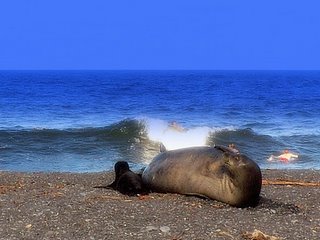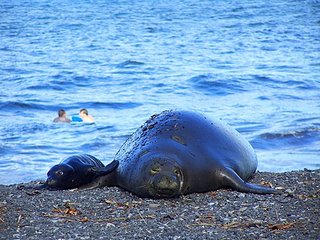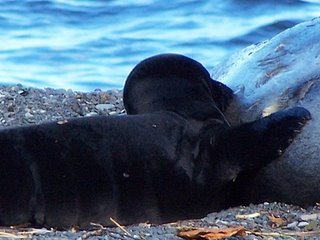Seal of Approval




East Hawaii beach hosts mom and pup seal
By Karen Welsh
The waves pounded the shoreline, remnants of a storm system that passed through the Big Island. The tide was steadily rising, making it the perfect time for a quick retreat.
Suddenly, the snappy bark of a female Hawaiian Monk Seal was heard above the surf at a remote beach location near Papaikou, in East Hawaii.
The momma seal loudly beckoned her 10-day-old pup to higher ground.
The baby, with the froth of milk still on it’s black whiskers from a recent nursing answered back as a sassy child, unwilling to obey and make the climb up the steep shore.
After a few more commands, the pup seal finally relented, following its mom up to a safer haven.
The mom gave birth on the beach less than two weeks ago and has intensely nurtured her pup. It's in her nature and she will neither eat nor drink until the baby is weaned and can become more independent.
During that time, the seal, now weighing somewhere between 600 to 700 pounds, will lose 200 pounds, while the baby, which weighed 25 to 30 pounds at birth, quickly gains between 5 to 8 pounds per day.
Most of the time, however, the two monk seals lounge lazily about at the edge of the shore. The mother wants to sleep, while the baby remains in constant motion after it wakes up from a nap.
A yellow rope barricade keeps people at bay. Signs are posted to warn off those who might get too close.
It’s already a long, steep climb down the edge of a ravine, and an even longer climb back uphill. If that’s not enough of a deterrent, David Schofield, the regional marine mammal response coordinator for the National Oceanic and Atmospheric Administration said the mammals are federally protected under the Marine Mammal Protection Act and the Endangered Species Act and need to be treated appropriately at all times.
An around-the-clock vigil is now being posted by the University of Hawaii Marine Biology volunteers, in conjunction with the NOAA Fishery Service and the Department of Aquatic Resources and Schofield said their directions must be taken seriously.
"If they ask you to do something, please heed their advice and move away," he said. "They have the authority."
Schofield said the guidance is meant to avoid injury to both the mammals and humans, as the mother seal will protect her young and will attack if anyone gets too close.
The best thing the public can do, Schofield stressed, is to simply stay away from the beach for another four to five weeks, as they don’t want the mother seal to prematurely abandon the baby.
"This is a critical time," he said. "This is the early critical period. It’s important to not disturb the nursing behavior."
It's hard to tell if the mother and pup understand the hoopla surrounding the blessed event. The two remain close to one another, as if they are the only two creatures on earth. Unabashedly, the little one nudges it's head, signaling the caretaker to turn her lumbering body, allowing the babe to nurse, the circle of life continuing against all odds.
Karen Welsh can be reached at writeaway777@hawaii.rr.com


1 Comments:
Karen, we get seals on the winter beach here on the east coast. People want to go up to them, even pet them! I may feature a story about them coming ashore in a future issue of OCEAN to better educate beachgoers. Glad you posted this story.
Post a Comment
<< Home